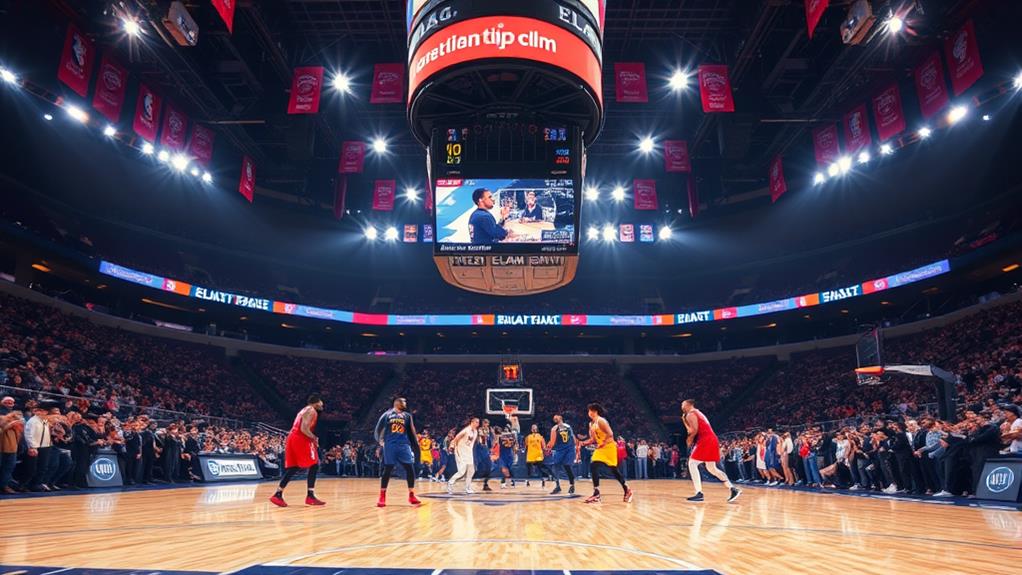
The Elam Ending: How It Works and Why It’s Changing Basketball
September 28, 2024The Elam Ending changes basketball by eliminating the game clock in the fourth quarter and introducing a target score—eight points beyond the leading team's score. This makes every possession vital, boosting excitement and competitiveness. As teams endeavor to reach this target score, intentional fouling declines, maintaining game flow. You can expect intense finishes, especially since its adoption in the NBA All-Star Game, where it's markedly increased viewer engagement. Fans and players have shown overwhelming support for this format. For a closer look at its origins and broader impact, keep exploring the fascinating elements that redefine modern basketball.
Overview of the Elam Ending
The Elam Ending introduces a fresh approach to the final moments of basketball games by turning off the game clock in the fourth quarter. Instead of counting down the minutes, teams focus on reaching a predetermined Target Score, which is set by adding 8 points to the leading team's score. For example, if the score is 80-72, the Target Score becomes 88.
This shift not only enhances the competitive stakes but also ramps up the intensity of the game, especially for trailing teams that need to step up their efforts on both offense and defense. By encouraging a faster pace of play, the Elam Ending aligns with the modern trend of optimizing player efficiency and scoring strategies, as seen in data-driven strategies that maximize shot selection accuracy.
First adopted by The Basketball Tournament in 2018, the Elam Ending has gained traction in various basketball leagues, including the NBA All-Star Game. By removing time management strategies, it encourages teams to prioritize scoring over merely running out the clock.
This results in thrilling finishes and dramatic comebacks, making every possession critical. The Elam Ending reshapes how you experience basketball, ensuring that the final moments are filled with excitement and urgency, ultimately creating a more engaging and competitive atmosphere for players and fans alike.
Mechanics of the Elam Ending
Under four minutes remaining in a game, the Elam Ending shifts the focus from the ticking clock to the thrill of scoring. When this rule kicks in, the game clock is turned off, allowing players to concentrate on reaching the Target Score. This score is determined by adding a fixed number of points, typically 8, to the leading team's score. For example, if the score is 80-72, the Target Score becomes 88. The first team to reach or exceed this score wins the game, creating a sense of urgency and excitement.
This approach mirrors the importance of maintaining fair competition and strategic gameplay, much like how the offside rule balances game dynamics in soccer.
The Elam Ending also keeps the game dynamic by enforcing the shot clock, which prevents teams from stalling or resorting to intentional fouling. This guarantees that the game flows smoothly toward its conclusion, culminating in a made basket that decides the winner.
Players can no longer rely on clock management to secure a victory; instead, they must focus on their offensive strategies and execution. As the basketball world embraces this innovative format, it's clear that the Elam Ending transforms the final moments of games into electrifying contests, where every possession counts.
Impact on the NBA All-Star Game

The Elam Ending has transformed the NBA All-Star Game by making it more competitive and engaging for players and fans alike.
This innovative approach has drawn parallels to other sports formats, sparking discussions around potential adaptations in formats such as soccer, where inspiration stories of teamwork and resilience play an essential role.
With a target score that honors Kobe Bryant, it adds significant meaning to the game's final moments.
This new format not only boosts viewer engagement but also prompts the league to contemplate its use in regular season play.
Enhanced Game Competitiveness
Enhanced competitiveness has transformed the NBA All-Star Game since the introduction of the Elam Ending in 2020. By setting a target score of 24 points to honor Kobe Bryant, the league shifted the dynamics of the fourth quarter, creating an atmosphere filled with urgency and intensity.
No longer are the final minutes marked by low effort; instead, teams now release aggressive defensive plays and strategic charges, raising the stakes considerably.
Viewership has responded positively, with TV ratings for the fourth quarter skyrocketing during the 2020 All-Star Game. This surge reflects a newfound excitement and engagement that fans have craved.
Players themselves have praised the Elam Ending for fostering a competitive spirit that invigorates the game. Subsequent All-Star Games in 2021 and 2022 have maintained this heightened intensity, proving that the Elam Ending isn't just a one-time success.
As the NBA continues to explore the potential for implementing this format in other settings, it's clear that the Elam Ending has made a lasting impact, enhancing the competitiveness of the All-Star Game and engaging audiences like never before.
Target Score Significance
Setting a target score in the Elam Ending brings a unique significance to the NBA All-Star Game that resonates with both players and fans. By introducing this innovative format, the game is played in a way that heightens its competitive nature, making it more thrilling and engaging. The 2020 All-Star Game is a prime example, where the target score was set 24 points above the leading team's score to honor Kobe Bryant, greatly enhancing the game's emotional resonance.
This structure has led to several notable impacts:
- Players exhibit heightened defensive efforts and critical plays to reach the target score.
- Viewer engagement spikes, especially during the dramatic fourth quarter.
- The excitement reflects in surging TV ratings, indicating a growing interest in the format.
- The success of the Elam Ending has sparked discussions about potentially adopting it for regular-season NBA games.
With its ability to transform traditional basketball dynamics, the Elam Ending hasn't only revitalized the NBA All-Star Game but also opened doors for future innovations in the sport.
Viewer Engagement Boost
By transforming how the game reaches its conclusion, the Elam Ending has considerably boosted viewer engagement during the NBA All-Star Game. Introduced in 2020 with a target score set at 24 points to honor Kobe Bryant, this new scoring format has heightened competitiveness in the fourth quarter.
Fans witnessed a dramatic increase in intensity, with players diving for loose balls and executing high-stakes defensive plays, which made the game more exciting.
The impact on viewer engagement is evident in the surge of TV ratings during the fourth quarter of the 2020 All-Star Game. Fans responded positively to the Elam Ending, leading to its return in the 2021 and 2022 games, marking a consistent trend in enhancing excitement.
Social media feedback further highlights this success, with an impressive 90-95% approval rating from fans and players alike.
With its innovative approach, the Elam Ending not only captivates audiences but also transforms the experience of the NBA All-Star Game. You can feel the thrill as teams battle for that target score, making every moment count and keeping you on the edge of your seat.
Advantages of the Elam Ending
The Elam Ending brings several advantages to the game that you might find appealing.
By eliminating intentional fouling and the game clock in the final moments, it creates a smoother flow and leads to thrilling finishes.
This format aligns with the principles of efficient play creation for high percentage shots, encouraging players to focus on scoring, making every play more exciting.
You'll notice how this format encourages players to focus on scoring, making every play more exciting.
Eliminates Intentional Fouling
Intentional fouling has long been a frustrating aspect of basketball's closing moments, but the Elam Ending effectively eliminates this tactic. By removing the game clock and establishing a target score, the focus shifts from managing time to scoring. This change promotes a competitive atmosphere where teams are encouraged to improve their defensive plays rather than resorting to fouling strategies.
Here are some key advantages of this approach:
- Reduced instances of intentional fouling: Teams concentrate on making baskets instead of stopping the clock.
- Increased competitiveness: The target score drives teams to perform at their best, enhancing the high-stakes nature of the game.
- Continuous gameplay: Without a clock, the game flows more naturally, creating a thrilling experience for both players and fans.
- Guaranteed exciting finishes: Every game concludes with a made basket, rather than free throws, ensuring memorable moments.
Statistical analysis shows that teams using intentional fouling have only a 1.5% success rate in prolonging games. The Elam Ending not only addresses this issue but also elevates the overall excitement and quality of basketball.
Enhances Game Flow
Focusing on gameplay instead of clock management drastically enhances game flow under the Elam Ending. By eliminating the traditional game clock in the final moments, this innovative format promotes continuous action, allowing players to engage freely in scoring opportunities without the pressure of time constraints. This shift not only elevates the pace of the game but also fosters a more fluid and athletic style of play.
With the focus on scoring rather than managing the clock, teams can better concentrate on their offensive and defensive strategies, leading to heightened competitiveness on the court. The Elam Ending guarantees that every game concludes with a made basket, steering clear of free throws and avoiding intentional fouling tactics. This approach creates an exciting atmosphere where every possession counts, resulting in thrilling finishes that captivate fans.
Moreover, the Elam Ending has been shown to boost viewer engagement, particularly during those critical moments in games. For example, the 2020 NBA All-Star Game saw surging TV ratings in the fourth quarter, demonstrating how this format keeps fans on the edge of their seats, enthusiastic for the next scoring play.
Promotes Exciting Finishes
In moments of high tension, the Elam Ending transforms basketball into a spectacle of thrilling finishes. By eliminating the game clock and focusing on a target score, the format encourages teams to compete fiercely until the final basket. This shift not only enhances the excitement but also leads to more fluid play during critical moments.
Key advantages of the Elam Ending include:
- Elimination of intentional fouling: This results in dynamic back-and-forth action, keeping fans on the edge of their seats.
- Exciting finishes: Every game concludes with a made basket, ensuring that you witness dramatic, clutch performances rather than drawn-out free throw situations.
- Increased fan engagement: Social media feedback shows a 90-95% approval rating from fans and players alike, particularly during events like the NBA All-Star Game.
- Thrilling conclusions: The focus on scoring rather than running out the clock creates a sense of urgency, making every possession count.
Origin of the Elam Ending

The Elam Ending emerged from Nick Elam's desire to shake up late-game basketball dynamics by eliminating the traditional game clock. Frustrated by the inefficacy of fouling strategies during NCAA Tournament games, he began researching potential improvements in 2004.
Over a decade, he analyzed more than 2,000 basketball games and discovered that trailing teams only managed to extend games through fouling a mere 1.5% of the time. This inefficiency echoed historical trends in game regulations and team dynamics, emphasizing the need for innovative solutions. Elam's approach aligns with the ongoing evolution of gameplay aimed at enhancing fairness and excitement, as seen in the evolution of equipment and player gear.
In August 2016, Elam proposed the Hybrid Duration Format, a detailed 300-page book outlining his vision for a rule change that focused on a Target Score instead of a ticking clock. The concept aimed to enhance the excitement and competitiveness of late-game situations, encouraging teams to play to a specific score rather than simply running out the clock.
The Elam Ending was first implemented during The Basketball Tournament (TBT) in 2017, where it garnered positive feedback for its ability to create thrilling finishes.
Implementation in Other Leagues
As leagues seek to enhance the excitement and competitiveness of their games, many have turned to the Elam Ending as a solution. The Canadian Elite Basketball League (CEBL) was the first to permanently adopt the Elam Ending, starting with its 2020 Summer Series. This implementation has greatly boosted player experiences and game excitement, similar to the impact of consistent halftime duration on soccer games.
Similarly, the NBA G League adopted the Elam Ending for overtime, allowing teams to compete to a target score instead of a game clock, resulting in engaging finishes.
The Elam Ending's influence doesn't stop at basketball; it's also sparking interest in other sports. Here are some notable implementations:
- CEBL: First league to permanently adopt the Elam Ending.
- G League: Uses the Elam Ending for overtime scenarios.
- NBA All-Star Game: Featured a target score of 24 points, leading to a thrilling fourth quarter.
- Soccer: Adaptations are being tested, such as in The Soccer Tournament (TST).
With its growing popularity, the Elam Ending is changing how you experience competitive sports, making each game more thrilling and engaging.
Challenges and Skepticism

Some fans and analysts have raised valid concerns about the Elam Ending, fearing that it could strip away the strategic elements that make late-game situations so gripping.
Traditionalists worry that without a game clock, important tactics like clock management and timeouts might lose their significance. Critics argue that the thrilling moments of last-second buzzer-beaters could diminish under this new format, as the focus shifts to reaching a pre-set target score rather than outmaneuvering the clock.
As basketball evolves, defensive strategies must also adapt, with teams needing to prioritize strong perimeter defense to counteract changing offensive styles. This skepticism doesn't just come from fans; some players and coaches expressed resistance during initial trials.
Adapting to an untested format that deviates from long-standing norms can be intimidating, leading to mixed responses in the early stages. There's a fear that excitement levels could fluctuate, making game endings less thrilling when teams no longer race against time.
While the Elam Ending has found positive reception in leagues like the CEBL and NBA, the pushback remains significant.
As debates continue, the challenge lies in balancing innovation with the cherished traditions that have defined basketball for generations.
Future Prospects and Adaptations
While many fans and analysts remain skeptical about the Elam Ending, its future prospects look promising as leagues continue to test and adopt the format. The G League adopted the Elam Ending for overtime periods, indicating its potential for regular season play.
As excitement builds, the upcoming NBA All-Star Game in February 2024 will celebrate the 20th anniversary of Nick Elam's initial discussions on game-ending flaws, offering another chance to showcase this innovative system. The adoption of unique scoring methods, like the Elam Ending, could also lead to a reimagining of game strategy, similar to how Bill Russell's record-breaking 11 championships highlighted the importance of winning culture in basketball.
The Elam Ending has already gained traction in the Canadian Elite Basketball League, which made it a permanent feature in 2021. Additionally, ongoing analysis is revealing the benefits and challenges of the format, which may lead to adaptations in other sports.
Here are some key points regarding its future:
- Increased adoption in professional leagues
- Potential for a more engaging fan experience
- Opportunities for adaptations in other sports, like soccer
- Growing community support and enthusiasm
With each successful implementation, the Elam Ending's potential to reshape basketball becomes more apparent, paving the way for a new era in sports scoring.
Conclusion
As you picture the electrifying atmosphere of a game nearing its climax, the Elam Ending breathes new life into basketball. It transforms every second into heart-pounding drama, where every basket matters and victory hangs by a thread. Embracing this innovative format could reshape how you experience the sport, turning nail-biting finishes into a thrilling art form. So, as the game evolves, you'll find yourself drawn deeper into the excitement, witnessing basketball's bright future unfold before your eyes.


